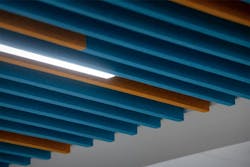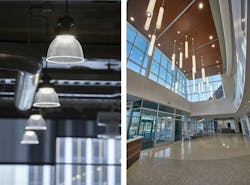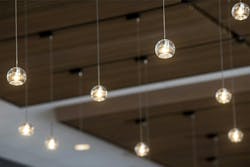It’s a beautiful summer evening. You and your friend are taking a stroll around a park in your town and before you know it, the sun has set. Suddenly you realize there is very little lighting above the sidewalk you are walking on, you are unable to read signage for directions, and the few lights that are in place only light up a small portion of the direct sidewalk under them.
How are you supposed to safely get back to your car?
Why is site lighting important?
Illuminating a site is more than bright lights on a building. When considering how to light a site while focusing on decreasing energy bills and consumption, you must consider the right light, the right place, and the right time. We’ve got some tools, resources, and next steps to guide you through this process.
Visual + Biological cues
Lighting provides us with both visual and biological cues, both the ability to visually navigate through a space and to take in our surrounding environment. There are biological impacts of light on our bodies as well. Light enters the eye and is transmitted to our brains, sending signals to our body to regulate things like our nervous and immune systems.
Light, especially at night, can have a significant impact on us visually, psychologically, and biologically, so it’s important to recognize the impact of exterior lighting on the people who use it.
Energy consumption
In addition to researching how lighting affects humans, another key conversation in the lighting industry is energy consumption. Did you know that 11% of electricity use in the United States is from lighting? Exterior lighting can be a huge contributor to your energy bills as well as the carbon footprint of a campus or facility.
Studies also show that upgrading from a less efficient light source and older lighting technology to an LED fixture can reduce costs by 50% (depending on the initial installation and how many fixtures are changed). If additional controls are introduced, the amount you can save increases even more.
When thinking about a campus, there are more than just streetlights—what we typically think of when we hear “site lighting.” There are lights for parking lots, parking garages, athletic fields, or outdoor spaces students use in addition to their academic experience. There are various fixtures and spaces that contribute to an energy bill and energy consumption.
First, let’s talk about efficacy—a fancy word for efficiency. Efficacy is the measurement of light that comes out of a fixture per unit of electricity. It’s measured in lumens per watt, which is how much light comes out of a fixture versus how much power you’re using to power the light. LEDs are the most efficient light source out there. You often see an average of 150 to 200 lumens per watt—compared to a metal halide version at 70 to 80 lumens per watt.
Next, you want to consider the quality of the light. We first look at color temperature (CCT). This is the shade or color of light that comes out of the fixture—warm white or cool white lighting.
You may have noticed while shopping for an LED replacement bulb that color is measured in Kelvin temperature. The higher the Kelvin temp, the cooler the light. This may seem counter-intuitive, but if you think about a fire, the hottest part of the fire in the center is a blue flame; further from the center, the cooler the temperature the warmer the fire light glows.
LED lighting provides a much broader range of color temperature compared to a metal halide—a common streetlight or exterior light. Metal halides tend to be very warm in color which can distort the perception of a space and make buildings and landscaping look less appealing.
The other quality to consider is the color rendering index (CRI), which is the ability of a light to reveal the true color of something as compared to natural daylight. Fixtures with a high CRI present objects and their colors more closely to how they appear naturally. LEDs are able to achieve a much higher color rendering index.
A typical fluorescent light is between 60-70% of the color rendering of natural daylight, and LEDS standardize at 80% CRI. Again, the more accurate reflection of color makes a space feel more natural and comfortable even at night.
Where is the right place?
One of the biggest conversations for exterior lighting is—where are you shining the light? This is where we shift our focus to directional lighting. This can mean light aimed at an intentional spot on a building for aesthetics or can mean shielding light from illuminating the sky to avoid wasting energy in a parking lot.
LEDs tend to have optimal fixture optics because they are a directional light source. Imagine how different fixtures are constructed: a metal halide or fluorescent bulb—basically an orb that glows—is placed inside a fixture housing such as a shoebox style pole head or a cone-shaped flood light. A significant portion of the light is lost inside the fixture itself, because it is not being directed OUT of the fixture, but rather bouncing around and off of a reflector or housing. In an LED fixture, there is a board with tiny diodes (a diode is a semiconductor device that essentially acts as a one-way switch for current) on it. Light is aimed out of the fixture, with much less wasted light bouncing around.
Another consideration when evaluating where to shine exterior lighting is light pollution. Light pollution is the presence of unwanted, inappropriate, or excessive electric lighting, and it has become an increasingly popular topic of conversation for both human interaction and our exchange with the ecosystem and environments around us. In urban areas, light pollution could be a distraction to those trying to sleep in an apartment above or simply relax in the evening hours. When looking at the environment around your site, electric light can affect a number of ecosystems including bird, turtle, and insect populations.
When is the right time?
The best exterior lighting strategy only uses the light we need when we need it. Different times of day may not demand as much lighting as other times. Adding in some technology controls for exterior lighting can help manage this and reduce energy consumption at the same time. In older lighting technologies, providing dimming capabilities was usually a significant cost increase and often required more complex and less user-friendly control systems. Now, LEDs are very easily controlled and dimmed. Plus, there are now options for controls to be mounted in individual fixtures, or to be run wirelessly, reducing the cost of wiring and infrastructure needed to manage exterior lighting systems.
With the rapidly changing control technologies, we are able to incorporate things like occupancy and daylight controls, as well as time-of-day scheduling for exterior and site lighting. For example, in a parking garage, lights can operate at 25% until an occupancy sensor detects a car entering the garage, and the lights can come on to full brightness.
Or, in a parking lot the lights can be dimmed down to 10% during late hours when the building is unoccupied, providing enough light for security cameras but not using so much energy when nobody is around to need the light to see. These solutions, along with other controls, can lead to a lighting system that only uses the energy it needs to create safe and welcoming exterior environment.
Lighting tools, resources, and next steps
Planning site lighting can be a daunting task. It’s easy to assume that we are reducing our energy usage because light fixtures and technology are more efficient; but actually in 2022, the electricity consumption for lighting increased. Knowing how much lighting is needed in a space can help manage energy consumption. It helps to have an intention behind what you are trying to highlight on your building’s exterior and surrounding space to avoid unnecessary light pollution. Layer controls into your lighting system to make them work for you and your environment.
The Department of Energy has a program called Better Buildings. They provide some decision-making tools and diagrams that can help you decide which areas are the most important to start with and how much impact you could have. They also provide some resources for grant money or incentives that will help make the project a little more palatable from a financial standpoint. In addition, a number of utilities have rebates or incentive programs, especially for lighting retrofits. A great resource for this is dsireusa.org. The website allows you to filter by state and it will tell you all energy-related incentives available. From there, you can filter by type of incentive.
Determining the right light, the right place, and the right time for lighting can be a timely effort. Understanding your current situation, identifying priorities, and creating a master plan and budget will help you reach your goals. Reach out to lighting designers at DC to help you transform your exterior lighting and save on energy!
About the Author
Design Collaborative
Design Collaborative is an award-winning multi-disciplinary design firm founded in 1992, with the belief that through our work, we can improve people's worlds. With nationally recognized expertise and a passion for improving worlds, DC has grown to become consistently ranked amongst the top 100 firms in the country by staying focused on designing people-first places. At DC, we provide boutique firm experience with big firm expertise and resources. Our team includes architects, engineers, interior designers, cost estimators, graphic designers, and support staff. We are a one-stop solution, providing real-time collaboration and problem-solving. Follow Design Collaborative on Facebook, Instagram, and LinkedIn.







